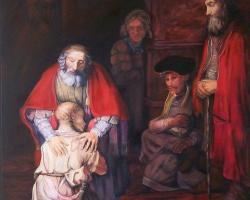Our students have been trained to read symbols. Draw a Nike swoosh or McDonald’s golden arches on a white board and everyone in the room will recognize them. Symbols are reminders that give us cues to stories, such as the burning bush or the crown of thorns. Christians use the ancient fish symbol for identification and the cross to remind us of Jesus’ sacrifice.
That’s why one way to engage students with the gospel is through a book such as Saints, Signs and Symbols (Church Publishing), which gives a visual representation and a short description of key saints, symbols, flowers and animals used throughout history to illustrate the story of God.
The Images of God’s Story
Before everyone had laptops and access to big-screen TVs and 3D movies, the story of God was told through sculptures and the stained glass of cathedrals and in book illustrations and paintings. The church was a leading promoter of the arts in order to help those who couldn’t read to know God’s story.
Rembrandt’s Prodigal Son and DaVinci’s Sistine Chapel ceiling are images that tell memorable stories. Many monks spent hours illustrating the Bible with symbols that tell the story and highlight the attributes of God and the apostles. God the Father, Son and Holy Spirit have symbols in art that remind people of the character and qualities of God. The apostles and saints were given symbols that told their stories and reminded viewers of their lives, deeds and how they died. (One example is that St. Patrick used a three-leaf clover to represent the Trinity.)
The Images of Students’ Stories
Students need to connect their stories to the grand story of faith, to traditions and to people—young and old, male and female—who have carried faith stories for generations.
Invite students to research a saint and explore how the saint’s story fits with their own. Have them compare an ancient saint with a contemporary person of faith. Have them use a Google or Wikipedia search to discover information about these people.
Give your students an example by choosing a symbol that reflects your own life story and share how it represents you and your faith. Conduct an exercise that allows your group to choose symbols or pictures that represent their stories. A fun way to do this would be to have them design their symbols as though choosing profile pictures for their Facebook pages. Be sure to allow ample time for students to share their choices and their reasons for them.
Some Tools to Help
In addition to Saints, Signs and Symbols: The Symbolic Language of Christian Art by Hilarie and James Cornwell (suggested above), here’s a resource that provides great information to improve biblical story telling:
• Shaped by the Story: Helping Students Encounter God in a New Way by Michael Novelli.
• Daily Devotion 365 Saints: Your Daily Guide to the Wisdom and Wonder of Their Lives by Woodeene Koenig-Bricker is a good introduction to the saints that includes practical application questions on each page.
• Jesus Freaks: Martyrs: Stories of Those Who Stood for Jesus: The Ultimate Jesus Freaks by DC Talk include stories to inspire.
• Celtic Way of Evangelism by George Hunter is a resource that offers a missional view.




